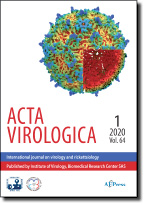Acta Virologica Vol.65, No.2, p.232-236, 2021
|
| Title: Intergenic recombination in feline calicivirus associated with a hemorrhagic-like disease in the Republic of Korea |
| Author: Sook-Young Lee, Yong-Kwan Kim, Young-Sik Kim, Eun-Jee Na, Yoon-Ji Kim, Jae-Ku Oem |
|
Abstract: Feline calicivirus (FCV) is a common cause of upper respiratory tract disease in cats. In this study, the complete genome sequence of FCV 14Q315, which was detected from a dead domestic cat with a hemorrhagic-like disease, was analyzed to identify the genetic characteristics. The FCV 14Q315 genome was 7,684 bp. Phylogenetic analyses based on the ORF1, ORF2, and ORF3 sequences indicated that FCV 14Q315 is more closely related to FCV 15D022 than to other FCV strains. ORF1 of FCV 14Q315 shared high sequence similarity with ORF1 of FCVs 15D022 and UTCVM-H1. We further evaluated genetic recombination in ORF1 of FCV 14Q315 and detected intergenic recombination between p30 and the ORF1/ORF2 junction with high significance. Particularly, the non-recombination region in ORF1 of FCV 14Q315 showed high sequence similarity with FCVs GX2019, CH-JL2, and 15D022. The recombination region in ORF1 of FCV 14Q315 showed the highest similarity with FCV UTCVM-H1, which is associated with a hemorrhagic-like disease. The results suggest that the UTCVM-H1-like FCV was introduced into the Republic of Korea and presumably recombined with Korean FCVs by occasional mixed infections. In addition, the Korean FCV strains were located in several phylogenetic clusters with marked genetic diversity in the ORF2 region. These results imply that Korean FCVs possess high genetic diversity owing to mutations and recombination. Furthermore, it is possible that certain FCVs caused cyclical infections in the Korean cat population based on a phylogenetic analysis of FCVs isolated at different time points.
|
|
| Keywords: calicivirus; virulent systemic feline calicivirus; recombination; hemorrhagic-like disease |
|
|
Published online: 17-Feb-2021
|
| Year: 2021, Volume: 65, Issue: 2 |
Page From: 232, Page To: 236 |
doi:10.4149/av_2021_206
|
|
 download file download file |
|
|
|
|
 download file
download file
